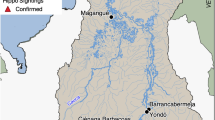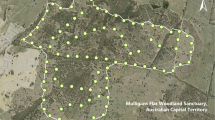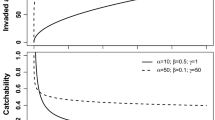Abstract
Allee effects, the reduction of vital rates at low population densities, can occur through several mechanisms, all of which potentially apply to reintroduced populations. Reintroduced populations are initially at low densities, hence Allee effects can potentially lead to reintroduction failure despite habitat quality being sufficient to allow long-term persistence if the population survived the establishment phase. The probability of such failures can potentially be reduced by releasing large numbers of organisms, by reducing post-release dispersal or mortality through management, or by directly managing the Allee effects, e.g., by implementing predator control or food supplementation until population size increases. However, such measures incur costs, as large releases have a greater impact on source populations, and management actions require financial and other resources. It is therefore essential to compare the costs and benefits of attempting to reduce Allee effects in reintroduction programs. Here we advocate the use of structured decision-making frameworks whereby alternative strategies are nominated, probability distributions of outcomes obtained under different strategies, and utilities assigned to different outcomes. We illustrate the potential application of such decision frameworks using projections from a stochastic population model including Allee effects. As there will seldom be estimates of Allee effects available from the species or system involved, it will be necessary to predict these effects based on the biology of the species and data from other systems. In doing so, it is important to identify mechanisms for proposed Allee effects, and to avoid misleading inferences from correlations subject to confounds. In particular, naive interpretations of correlations between numbers released and reintroduction success may exaggerate the benefits of releasing large numbers.



Similar content being viewed by others
References
Allee WC (1931) Animal aggregations: a study in general sociology. University of Chicago Press, Chicago
Andrewartha HG, Birch LC (1954) The distribution and abundance of animals. University of Chicago Press, Chicago
Angulo E, Roemer GW, Berec L, Gascoigne J, Courchamp F (2007) Double Allee effects and extinction in the island fox. Conserv Biol 21:567–577
Armstrong DP, Seddon PJ (2008) Directions in reintroduction biology. Trends Ecol Evol 23:20–25
Armstrong DP, Castro I, Griffiths R (2007) Using adaptive management to determine requirements of reintroduced populations: the case of the New Zealand hihi. J Appl Ecol 44:953–962
Bakker VJ, Doak DF, Roemer GW, Garcelon DK, Coonan TJ, Morrison SA, Lynch C, Ralls K, Shaw R (2009) Incorporating ecological drivers and uncertainty into a demographic population viability analysis for the island fox. Ecol Monogr 79:77–108
Berry R (1998) Reintroduction of kaka (Nestor meridionalis septentrionalis) to Mount Bruce Reserve, Wairarapa, New Zealand. Science for Conservation: 89. Department of Conservation, Wellington
Biggins DE, Vargas A, Godbey JL, Anderson SH (1999) Influence of pre-release experience on reintroduced black-footed ferrets (Mustela nigripa). Biol Conserv 89:121–130
Boukal DS, Berec L (2002) Single-species models of the Allee effect: extinction boundaries, sex ratios and mate encounters. J Theor Biol 218:375–394
Bradley DW, Ninnes CE, Valderrama SV, Waas JR (2011) Does ‘acoustic anchoring’ reduce post-translocation dispersal of North Island robins? Wildl Res 38:69–76
Bright PW, Morris PA (1994) Animal translocation for conservation: performance of dormice in relation to release methods, origin and season. J Appl Ecol 31:699–708
Castro I, Alley JC, Empson RA, Minot EO (1994) Translocation of the Hihi or stitchbird Notiomysis cincta to Kapiti Island, New Zealand: transfer techniques and comparison of released strategies. In: Serena M (ed) Reintroduction biology of Australian and New Zealand fauna. Surrey Beatty & Sons, Chipping Norton, pp 113–120
Caughley G (1994) Directions in conservation biology. J Anim Ecol 63:214–244
Clarke RH, Boulton RL, Clarke MF (2002) Translocation of the socially complex Black eared-miner Manorina melanotis: a trial using hard and soft release techniques. Pac Conserv Biol 8:223–234
Clemen RT (1996) Making hard decisions: an introduction to decision analysis. Duxbury Press, Belmont
Courchamp F, Macdonald DW (2001) Crucial importance of pack size in the African wild dog Lycaon pictus. Anim Conserv 4:169–174
Courchamp F, Berec L, Gascoigne J (2008) Allee effects in ecology and conservation. Oxford University Press, New York
Davies-Mostert HT, Mills MGL, MacDonald DW (2009) South Africa’s wild dog Lycaon pictus meta-population management programme. In: Hayward MW, Somers MJ (eds) The reintroduction of top-order predators. Blackwell Publishing, Oxford, pp 10–42
Dawes R, Smith TL (1985) Attitude and opinion measurement. In: Lindzey G, Aronson E (eds) The handbook of social psychology, 3rd edition edn. Random House, New York, pp 509–566
Dennis B (1989) Allee effects: population growth, critical density and the chance of extinction. Nat Resour Model 3:481–538
Deredec A, Courchamp F (2007) Importance of the Allee effect for reintroductions. Ecoscience 4:440–451
Frankham R, Ballou JD, Briscoe DA (2010) Introduction to conservation genetics, 2nd edn. Cambridge University Press, Cambridge
Gregory SD, Bradshaw CJA, Brook BW, Courchamp F (2010) Limited evidence for the demographic Allee effect from numerous species across taxa. Ecology 91:2151–2161
Griffith B, Scott JM, Carpenter JW, Reed C (1989) Translocation as a species conservation tool: status and strategy. Science 245:477–480
Hamilton LP, Kelly PA, Williams DF, Kelt DA, Wittmer HU (2010) Factors associated with survival of reintroduced riparian brush rabbits in California. Biol Conserv 143:999–1007
Hardman B, Moro D (2006) Optimising reintroduction success by delayed dispersal: is the release protocol important for hare-wallabies? Biol Conserv 128:403–411
Hastie R, Dawes RM (2010) Rational choice in an uncertain world: the psychology of judgment and decision-making, 2nd edn. SAGE Publications, Thousand Oaks
Hayward MW, Adendorff J, O’Brien J, Sholto-Douglas A, Bissett C, Moolman LC, Bean P, Fogarty A, Howarth D, Slater R, Kerley GIH (2007) The reintroduction of large carnivores to the Eastern Cape Province, South Africa: an assessment. Oryx 41:205–214
Hood GM (2010) PopTools, version 3.2.3. Available for download from http://www.poptools.org
IUCN (1987) IUCN Position Statement on the Translocation of Living organisms: Introductions, Re-introductions, and Re-stocking. Available for download from http://www.iucnsscrsg.org/
IUCN (1998) IUCN guidelines for re-introductions. Available for download from http://www.iucnsscrsg.org/
King SRB, Gurnell J (2005) Habitat use and spatial dynamics of takhi introduced to Hustai National Park Mongolia. Biol Conserv 124:277–290
Le Gouar P, Robert A, Chois JP, Henriquet S, Lécuyer P, Tessier C, Sarrazin F (2008) Roles of survival and dispersal in reintroduction success of Griffon vulture (Gyps fulvus). Ecol Appl 18:859–872
Martín-López B, Montes C, Benayas J (2008) Economic valuation of biodiversity conservation: the meaning of numbers. Conserv Biol 22:624–635
Matson T, Goldizen AW, Jarman PJ (2004) Factors affecting the success of translocations of the black-faced impala in Namibia. Biol Conserv 116:359–365
McCarthy MA, Armstrong DP, Runge MC (2011) Adaptive management of reintroduction. In: Ewen JG, Armstrong DP, Parker KA, Seddon PJ (eds) Reintroduction biology: integrating science and management. Wiley-Blackwell, Oxford (in press)
McLellan BN, Serrouya R, Wittmer HU, Boutin S (2010) Predation-mediated Allee effects in multi-prey systems. Ecology 91:286–292
Molles LE, Calcott A, Peters D, Delamare G, Hudson JD, Innes J, Flux I, Waas J (2008) "Acoustic anchoring" and the successful translocation of North Island kokako (Callaeas cinerea wilsoni) to a mainland management site within continuous forest. Notornis 55:57–68
Shier DM, Owings DH (2006) Effects of predator training on behavior and post-release survival of captive prairie dogs (Cynomys ludovicianus). Biol Conserv 132:126–135
Short J, Bradshaw SD, Giles J, Prince RIT, Wilson GR (1992) Reintroduction of macropods (Marsupialia, Macropodoidea) in Australia: a review. Biol Conserv 62:189–204
Sinclair ARE, Pech RP, Dickman CR, Hik D, Mahon P, Newsome AE (1998) Predicting effects of predation on conservation of endangered prey. Conserv Biol 12:564–575
Snyder NF, Derrickson SR, Beissinger SR, Wiley JW, Smith TB, Toone WD, Miller B (1996) Limitations of captive breeding in endangered species recovery. Conserv Biol 10:338–348
Somers MJ, Gusset M (2009) The role of social behaviour in carnivore reintroductions. In: Hayward MW, Somers MJ (eds) The reintroduction of top-order predators. Blackwell, Oxford, pp 270–281
Somers MJ, Graf JA, Szykman M, Slotow R, Gusset M (2008) Dynamics of a small re-introduced population of wild dogs over 25 years: Allee effects and the implications of sociality for endangered species’ recovery. Oecologia 158:239–247
Stephens PA, Sutherland WJ (1999) Consequences of the Allee effect for behaviour, ecology and conservation. Trends Ecol Evol 14:401–405
Stephens PA, Sutherland WJ, Freckleton RP (1999) What is the Allee effect? Oikos 87:185–190
Tavecchia G, Viedma C, Martinez-Abrain A, Bartolome M-A, Gomez JA, Oro D (2009) Maximizing re-introduction success: assessing the immediate cost of release in a threatened waterfowl. Biol Conserv 142:3005–3012
Towns DR, Ferreira SM (2001) Conservation of New Zealand lizards (Lacertilia: Scincidae) by translocation of small populations. Biol Conserv 98:211–222
Tuberville TD, Clark EE, Buhlmann KA, Gibbons JW (2005) Translocation as a conservation tool: site fidelity and movement of repatriated gopher tortoises (Gopherus polyphemus). Anim Conserv 8:349–358
Turchin P (1990) Rarity of density dependence or population regulation with lags? Nature 344:660–663
van Heezik Y, Seddon PJ, Maloney RF (1999) Helping reintroduced houbara bustards avoid predation: effective anti-predator training and the predictive value of pre-release behaviour. Anim Conserv 2:155–163
van Heezik Y, Maloney RF, Seddon PJ (2009) Movements of translocated captive-bred and released Critically Endangered kaki (black stilts) Himantopus novaezelandiae and the value of long-term post-release monitoring. Oryx 43:639–647
Wang G, Liang X-G, Wang F-Z (1999) The competitive dynamics of populations subject to an Allee effect. Ecol Model 124:183–192
Williams BK, Nichols JD, Conroy MJ (2002) Analysis and management of animal populations: modelling, estimation and decision-making. Academic Press, San Diego
Wittmer HU, McLellan BN, Serrouya R, Apps CD (2007) Changes in landscape composition influence the decline of a threatened woodland caribou population. J Anim Ecol 76:568–579
Wittmer HU, Ahrens RNM, McLellan BN (2010) Viability of mountain caribou in British Columbia, Canada: effects of habitat change and population density. Biol Conserv 143:86–93
Wolf MC, Griffith B, Reed C, Temple SA (1996) Avian and mammalian translocations: update and reanalysis of 1987 survey data. Conserv Biol 10:1142–1154
Acknowledgements
DPA thanks Gaku Takimoto and Tadashi Myashita for the invitation to speak on this topic at the Allee effects symposium at the 57th Annual Meeting of the Ecological Society of Japan, and to the Japan Society for the Promotion of Science KAKENHI (21770091 and 21310149) for funding this visit to Japan. We thank Tracy Rout for help with the decision analysis, and M. Hayward, J. Ewen, and two anonymous reviewers for comments on the manuscript.
Author information
Authors and Affiliations
Corresponding author
About this article
Cite this article
Armstrong, D.P., Wittmer, H.U. Incorporating Allee effects into reintroduction strategies. Ecol Res 26, 687–695 (2011). https://doi.org/10.1007/s11284-011-0849-9
Received:
Accepted:
Published:
Issue Date:
DOI: https://doi.org/10.1007/s11284-011-0849-9




